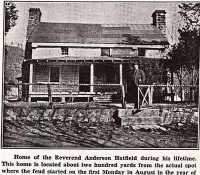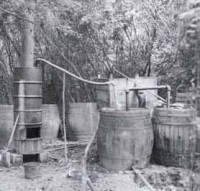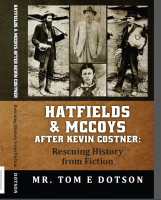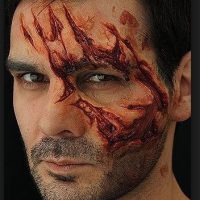[In this post, Thomas begins to discuss two themes that will appear frequently in his work on the feud. First, there is his antipathy to feud fictionalization, where writers feel free to manufacture convincing details and pass them off as if they have some historical foundation. This, Thomas would say, is a sleight of hand that helps the writer convince readers that he, or she, has some special knowledge of the events being described. Second is the tendency on the part of writers over the years to back-edit events or characters or stories into the feud and treat them as part of the feud. In this case, the historically real murder of Bill Staton by the brothers Paris and Sam McCoy is made, with no evidence, to be an outgrowth of earlier tensions between the two families. As the feud tale goes, Bill Staton, though more closely related to the McCoys, testified against Ran’l McCoy in the hog trial, thus costing Ran’l the hog and earning Staton the enmity of Ran’l’s nephews, Sam and Paris. According to this tale, Sam and Paris waited until the time was right and then killed Bill Staton. In later works, using actual court documents, Thomas will lay waste to this entire tale, adding context and separating it from the feud altogether. For now, though, he simply points out the ridiculousness of the tale as it is retold by Dean King. – RH]
As the only living witnesses to the killing of Bill Staton were the two men charged with his murder, everyone in Tug Valley wondered what really happened. Of course, no one believed that Sam and Paris McCoy were telling the whole truth, but the court was forced to find them not guilty, since there were no eyewitnesses to the killing and forensic science was still only a figment of Conan Doyle’s imagination.
We waited through one hundred thirty-three long years of ignorance until the publication of Dean King’s “True Story.” Now we know the story—not just the highlights, but right down to the minutest detail, such as eye movements and olfactory sensations. We know it is true, because King titled it the “True Story,” and the Washington Post, Boston Globe, Wall Street Journal and every other press organ that never lies to us said his research was “thorough” and his facts “straight”. You can read it on pp. 60-61 of King’s book, if you think you need to.
As the unsuspecting McCoy brothers strolled through the deep woods of Logan County, near the Tug River: “Hiding behind a bush, Staton raised his gun, propped it in the vee of the limbs, shut an eye, squinted down the barrel, and took a bead…”
I know there are some doubters out there who don’t think it possible that anyone could know exactly how Staton braced his rifle over a century ago in the woods. There are probably even more spoilers reading this who don’t think King could possibly know when someone shut an eye and squinted, but you just gotta believe! And, you ain’t heard nuthin’ yet.
“With his lungs swollen with the breath that stilled his body for shooting…”
“Wait! You yell. He wouldn’t be taking in a deep breath to still himself for shooting.” Everyone who’s been through basic training knows you breathe out, just before you squeeze one off.” My answer to such doubters is that neither of the three men in this little play ever went through basic, so how were they supposed to know that you breathe out before shooting someone?
Didn’t you see the movie where Sam, supposedly the best marksman on the Kentucky side of the River, shot at Devil Anse from a tree stand about twenty-five yards distant, and missed him completely? You just run that DVD back a couple of times and watch closely and you will see that Sam was breathing in when he pulled the trigger.
Now, King gets right down to the lick-log with his detail and tells us exactly what it was that Bill Staton sucked into his lungs a second before he busted a cap on Paris McCoy: “An inhalation of honeysuckle and deep forest scent.” I will admit that I have run into some people who are just plain contrary-natured who say they don’t believe that Dean King can sit in Richmond Virginia and sniff out what Bill Staton sniffed a hundred and thirty-three years ago by Tug River. When that happens, I simply read them a little of the review from the Boston Globe, and they get right back in line, waiting for the next move, which is:
“Paris McCoy…dropped to the ground…Staton’s rifle slug had pierced him through the hip.”
This was not a “flesh wound” like you see in so many westerns; it hit so much bone that it knocked him down. I know that in normal circumstances, a man hit through the hip so solidly by a high-powered rifle bullet that it knocks him down will not take another step for several months, but not when Dean King is calling the “play-by-play.”
With such a crippling, and often fatal wound, you might expect him to just lay on the ground moaning until the EMT’s arrived, but Paris “bounded to his feet” and shot Staton through the chest!
Staton’s wound was no simple “flesh wound” either. It was “spurting blood!” Now I know you would expect a man shot through the chest with a high-powered rifle, with the bullet placed so that the wound “spurted blood,” to immediately resort to prayer, or at least a verse or two of “O, Come, Angel Band,” but he did not!
Paris McCoy, with a shattered hip, and Bill Staton, bleeding from either the heart or a major connecting vessel, tossed their rifles aside, rushed at each other and engaged in a long and vicious fist-fight. “When they collided, they fought like cornered animals…punching, clawing and biting. Staton clenched his cousin’s (a McCoy) cheek in his teeth and slashed his face with dirt-rimmed fingernails. Blood spewed everywhere. Staton would have had Paris licked if it had not been for Sam.” The lung or heart-shot Staton was actually winning the fight with the crippled Paris McCoy, but Sam McCoy settled the matter by blowing Staton’s brains out from point blank range.
If you don’t believe a man who has just been shot through the chest with a high-powered rifle proceeded immediately to win a fist fight, then you can argue with the book reviewer from the Boston Globe, not with me, because hard as I try not to be disagreeable, I am also having some difficulty believing this tale.
I will admit that I gleaned one valuable piece of information from King’s reference to Staton’s “dirt-rimmed fingernails.” I now know why the court exonerated Sam for blowing Staton’s brains out from point-blank range. No jury would ever convict a man for shooting someone who was clawing the defendant’s brother’s face with dirty fingernails.





